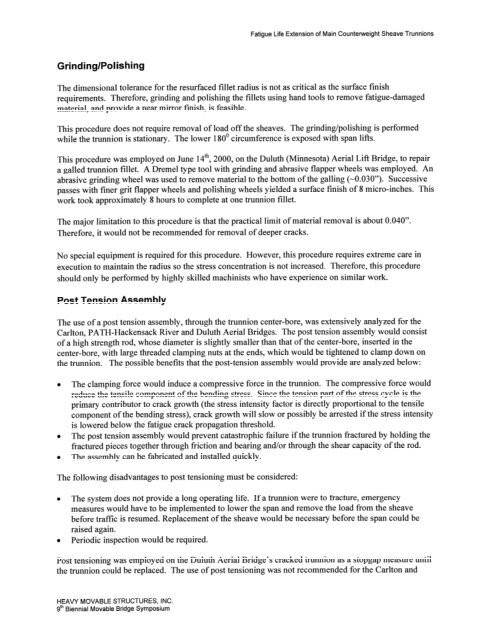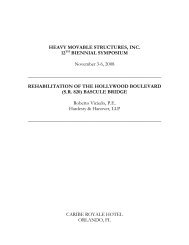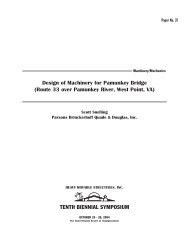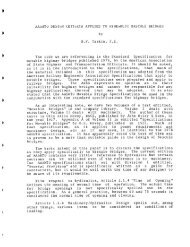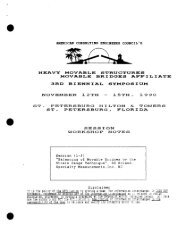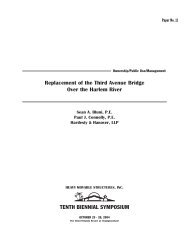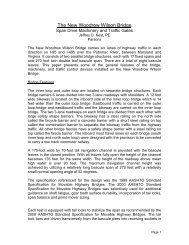Fatigue of Counterweight Sheave Trunnions - Heavy Movable ...
Fatigue of Counterweight Sheave Trunnions - Heavy Movable ...
Fatigue of Counterweight Sheave Trunnions - Heavy Movable ...
You also want an ePaper? Increase the reach of your titles
YUMPU automatically turns print PDFs into web optimized ePapers that Google loves.
<strong>Fatigue</strong> Life Extension <strong>of</strong> Main Countemeight <strong>Sheave</strong> <strong>Trunnions</strong><br />
The dimensional tolerance for the resurfaced fillet radius is not as critical as the surface finish<br />
requirements. Therefore, grinding and polishing the fillets using hand tools to remove fatigue-damaged<br />
material, and provide a near mirror finish, is feasible.<br />
This procedure does not require removal <strong>of</strong> load <strong>of</strong>f the sheaves. The grinding/polishing is performed<br />
while the trunnion is stationary. The lower 180' circumference is exposed with span lifts.<br />
This procedure was employed on June 14th, 2000, on the Duluth (Minnesota) Aerial Lift Bridge, to repair<br />
a galled trunnion fillet. A Dremel type tool with grinding and abrasive flapper wheels was employed. An<br />
abrasive grinding wheel was used to remove material to the bottom <strong>of</strong> the galling (-0.030"). Successive<br />
passes with finer grit flapper wheels and polishing wheels yielded a surface finish <strong>of</strong> 8 micro-inches. This<br />
work took approximately 8 hours to complete at one trunnion fillet.<br />
The major limitation to this procedure is that the practical limit <strong>of</strong> material removal is about 0.040".<br />
Therefore, it would not be recommended for removal <strong>of</strong> deeper cracks.<br />
No special equipment is required for this procedure. However, this procedure requires extreme care in<br />
execution to maintain the radius so the stress concentration is not increased, Therefore, this procedure<br />
should only be performed by highly skilled machinists who have experience on similar work.<br />
Post Tension Assembly<br />
The use <strong>of</strong> a post tension assembly, through the trunnion center-bore, was extensively analyzed for the<br />
Carlton, PATH-Hackensack River and Duluth Aerial Bridges. The post tension assembly would consist<br />
<strong>of</strong> a high strength rod, whose diameter is slightly smaller than that <strong>of</strong> the center-bore, inserted in the<br />
center-bore, with large threaded clamping nuts at the ends, which would be tightened to clamp down on<br />
the trunnion. The possible benefits that the post-tension assembly would provide are analyzed below:<br />
The clamping force would induce a compressive force in the trunnion. The compressive force would<br />
reduce the tensile component <strong>of</strong> the bending stress. Since the tension part <strong>of</strong> the stress cycle is the<br />
primary contributor to crack growth (the stress intensity factor is directly proportional to the tensile<br />
component <strong>of</strong> the bending stress), crack growth will slow or possibly be arrested if the stress intensity<br />
is lowered below the fatigue crack propagation threshold.<br />
The post tension assembly would prevent catastrophic failure if the trunnion fractured by holding the<br />
fractured pieces together through friction and bearing and/or through the shear capacity <strong>of</strong> the rod.<br />
The assembly can be fabricated and installed quickly.<br />
The following disadvantages to post tensioning must be considered:<br />
The system does not provide a long operating life. If a trunnion were to fracture, emergency<br />
measures would have to be implemented to lower the span and remove the load from the sheave<br />
before traffic is resumed. Replacement <strong>of</strong> the sheave would be necessary before the span could be<br />
raised again.<br />
Periodic inspection would be required.<br />
Post tensioning was employed on the Duluth Aerial Bridge's cracked trunnion as a stopgap measure until<br />
the trunnion could be replaced. The use <strong>of</strong> post tensioning was not recommended for the Carlton and<br />
HEAVY MOVABLE STRUCTURES, INC.<br />
gth Biennial <strong>Movable</strong> Bridge Symposium


